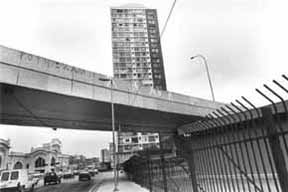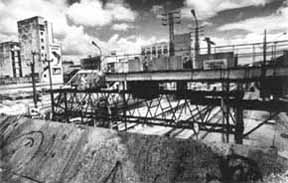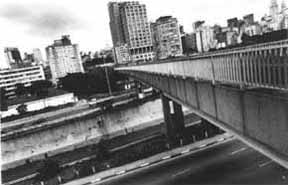intervals |
|
|
Disconnection
/ Intervals





Today all urban experience implies rupture, distance. Attempts to articulate a
fragmented space, through the insurmountable discontinuities between its parts.
Intervals engendered inside the city. The East Zone of São Paulo is an example
of these interruptions, appeared in the midst of the discontinuous surface of
megalopolis.
The rupture of the urban fabric triggered a multiplication of local patterns that spread out and articulate with others configurations, not obeying the economy and transport organization of the city. The space is taken by events (abandoned and reappropriated sites, fairs, and unexpected uses), more than by finished things. The metropolis expels spaces _ debris, slums, terrain-vagues _ that are not delimited by the patterns of money, production or habitation.1
Small intervals, interstices in the urban territory, that reconfigure it permanently. Each enclave _ the occupation of an area for homeless, peddlers or tenement houses, the installation of a new center of commerce (shopping centers and large surfaces), the sprouting of habitation condominiums _ redraw the region in adjusting itself by accumulation with other local parts, a juxtaposition that composes a heterogeneous space in continuous variation.
The resultant space appears as an amorphous recollection of juxtaposed parts without bonds between them. It can be defined by accumulation, independently of any reference to a metric. Each juxtaposition creates an indiscernibility zone: areas of passage and changes of direction. Intervals produced by the discontinuity of the territory, the fragmented process of spacialization. In this space without contours nor limits, without neither beginning nor end, we are always in the middle. Here all movement establishes an area of neighborhood, a no-man-land, a non-located relation between distant or contiguous points. This neighborhood (border) is indifferent to contiguity and to distance.
It is the space of the short intervals, where the smoothing of the proximities is made independently of any specific path. It is an area of contact, constructed by local operations with direction changes. It operates by close to close: it is a local space of connections. A territory established by articulations of local parts, operations of passage.
The resultant urban configuration is a fragmented space, articulated through the insurmountable discontinuities between its parts. Intervals that keep the traces of the past as much of the future, unfolding of a volume that produces its proper space. Production of a dimension inside itself, and not anymore organized from another absent place, from a non-place or a utopia. Configuration of a field that assimilates in itself the difference, the unfolding in another one.2
Reference
1 G. Deleuze. Mille Plateaux, Paris, Minuit, 1980.2 J. Derrida. L‘ecriture et la différence, Paris, Seuil, 1967 e Marges - de la philosofie, Paris, Minuit, 1972.